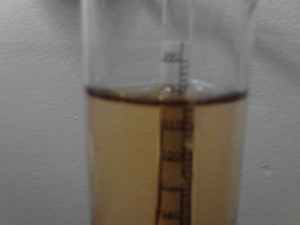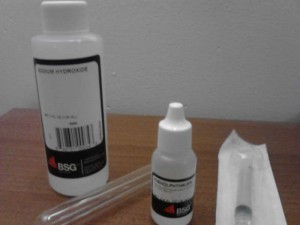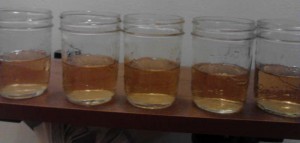So you made your hard cider and it’s flat. It’s watery. It’s insipid. Don’t despair and don’t throw it out! By doing a little experimentation, tasting, and mathematics, you could transform mediocre cider into something you actually want to drink and learn a little bit about chemistry while you’re at it. Let’s establish our baselines and meet the tools.
Step 1: Know what you have
It’s silly to talk about making adjustments if we don’t know what we’re starting with. Let’s establish our baselines of specific gravity, ABV, and acidity.
Specific gravity is measured using a hydrometer. Put a sample of the finished cider in a test jar and float the hydrometer. A completely fermented cider will read 0.998 S.G. This means that all of the sugar has been converted to alcohol. It also means that there is no residual sugar to make your cider taste sweet. If your reading is above 0.998, there should be some degree of sweetness when you taste the sample.
ABV is calculated by using two SG readings. Use this formula:
![]()
Ex. Starting SG = 1.043, Final SG = 0.998
ABV = (1.05/.79)((1.043 – 0.998)/(0.998))*100 = 5.99% ABV
If you didn’t take a starting gravity reading, don’t worry about it. It doesn’t really matter as there’s not much you can do to adjust it at this point. Most hard cider fermented from pressed juice will be around 6% unless sugar is added before fermentation.
Measuring acidity uses some high school chemistry practice. Don’t worry, it’ll be fun! First, get yourself an Acid Test Kit that contains a solution of sodium hydroxide, phenolphthalein reagent, a test tube, and a syringe. You need to use this kind of kit instead of pH strips because we need to know the TA (titratable acidity) to make precise adjustments. The strips will only give you a general idea of how much free hydrogen is in solution and gives no information on what kind of acid it is. TA solves this by making tartaric acid the standard and calculating from there, but I digress. Your kit should come with instructions, but if you need some try these.
For our example, let’s assume that the final SG was 0.998, the ABV was 6%, and the TA was a paltry .30 (actual results from a recent batch).
Step 2: Meet your adjustment toolkit
Now, let’s meet the various chemicals that we can use to really dial-in your cider.
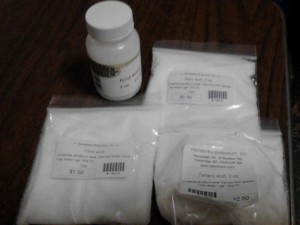 Acids. There are a variety of acids you can use to adjust the TA. The main difference is their typical source, which could make a slight impact on the flavor. Citric (from citrus fruits), tartaric (from grapes), malic (from apples), and acid blends (usually all three in equal amounts) all do approximately the same thing, which is to raise the TA of your cider by .15% when used at the rate of 1 tsp per gallon.
Acids. There are a variety of acids you can use to adjust the TA. The main difference is their typical source, which could make a slight impact on the flavor. Citric (from citrus fruits), tartaric (from grapes), malic (from apples), and acid blends (usually all three in equal amounts) all do approximately the same thing, which is to raise the TA of your cider by .15% when used at the rate of 1 tsp per gallon.
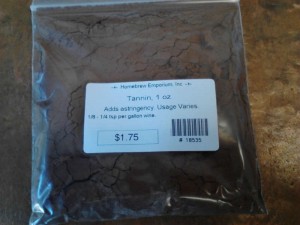 Tannins. Derived from grape skins & seeds, these lend an astringent, drying bitterness and body to your cider. Cider makers will use high-tannin apples or pears in their mix to get the tannins naturally. Those using juices typically chosen for sweet cider may be lacking this component.
Tannins. Derived from grape skins & seeds, these lend an astringent, drying bitterness and body to your cider. Cider makers will use high-tannin apples or pears in their mix to get the tannins naturally. Those using juices typically chosen for sweet cider may be lacking this component.
Sweeteners. A variety of sweet tasting substances can also be mixed in to raise that final SG. Table sugar, corn sugar, brown sugar, maltodextrin, honey, artificial (a particular favourite for English cider producers), ect will all work just fine. My personal favorite is adding back some unfermented sweet cider. Apple juice will work, as will concentrates. The most important thing to remember is that unless the hard cider has had all of the yeast removed, killed, or otherwise incapacitated, using a fermentable sugar will lead to further fermentation. This category includes glycerine, which sweetens the flavor and fills out the body without being an actual sweetener.
Carbonation. Either derived by yeast action or forced into solution using a kegging setup, the additional carbonic acid combined with the aromatics being hurled at your nose as you sip does wonders for pretty much any cider. It is tricky to make a cider that is both sweet and naturally carbonated, but I’ll share a few ideas later.
Spices. Of course a variety of common kitchen spices can also be used to tailor the final flavor. Cinnamon and clove are very common. I’ll leave this adjustment to the reader’s personal experimentation.
Step 3: Experimenting with adjustments
While we could just throw random measures of these various adjustments at our cider, this isn’t the Modern way. I want you to understand what each of these adjustments will do to your particular cider. The only way to do this is to make concentrated solutions of each, then mix with the unadulterated cider to find just the right combination to make this your cider. Let’s begin by making these concentrated solutions. Be warned that this section will feature a lot of calculation.
First, get yourself a bunch of convenient measuring vessels. I used half-pint mason jars.
In each of these I put 100 mL of my cider. I then started to make the concentrated solutions of acidity, tannins, and sweetness.
Acidity. 1 tsp in 1 gallon gives an increase of .15% TA. 1 teaspoon of acid blend is 5.1 grams (from here). 1 gallon is 3785 mL. 0.0013474 grams per mL yields .15% TA. Adding 1/2 tsp of acid blend to our 100 mL sample gives a concentration of .0255 grams per mL. You should taste a tiny bit so that you know a) what acidity does to your cider, b) the direction of any flavor components, and c) to never follow my advice to taste concentrated solution. Go ahead, it won’t kill you!
To restate the concentrations above, adding 1 mL of this concentrated solution to a 100 mL sample would give an increase of .0002525 grams per mL, which would correspond to an increase of .03% TA (roughly what 1 tsp of your acid would do in 5 gallons of cider). We can express this with the following formula:
% increase in TA = (x/(100 + x))*2.8388 where x = mL of the concentrated solution.
This is useful for experimental determination of the desired % TA. If we found that an additional 15 mL of the concentrated solution added to a 100 mL sample suited our tastes, we would know that we prefer our cider to have .67% TA (the baseline .30% TA + .37% TA in adjustment). This is useful as a reference.
Once we know our preference, we can use the inverse formula to calculate adjustments.
mL of the concentrated solution necessary = 100T/(2.8388 – T) where T = desired % increase in TA
For example, if we wanted to sample our cider with a TA of .60%, we would need to increase the TA from the .30% baseline, an increase of .30%. Plugging .30% TA into the second formula we get that we would need 11.8 mL of our concentrated solution.
Play around with different % TA as they affect the depth of flavor in a cider. Acidity can actually increase the apparent sweetness of a cider without adding any additional sugar.
Once you have determined the % TA you wish your final cider to have, you can calculate how many tsp of your acid to add using this formula:
tsp of acid necessary = (Desired %TA – Baseline %TA)/.15 * Volume (in Gallons)
Tannins. It is generally not recommended to add more than 1/4 tsp of tannins per gallon of wine or cider. From the table cited earlier, this is a concentration of .00015852 grams per mL. Go ahead and add that 1/4 tsp to your 100 mL sample to get a concentration of .006 grams/ mL. The tannins are mildly hydroscopic when introduced dry so stir them in and give them a little while to dissolve on their own. When they are dissolved, give your concentrated solution a taste to get an idea of what tannins are adding to the cider.
Let’s start at 1/3 of the maximum recommendation. This is only 1 mL added to a 100 mL sample. Give a little stir and taste. Then add another 1 mL. Again, stir and taste. Finally, add a third mL. 3 mL of concentrated solution added to a 100 mL sample is a little more than the maximum recommended at .00017476 g/mL
This adjustment is based purely on your perception. You can keep going if you want. Here’s the calculation based on the number of mL of concentrated solution you added to a 100 mL sample to arrive at your preference:
tsp of tannin = (# of mL * Volume (in Gallons) ) / 12
— TO BE CONTINUED —

